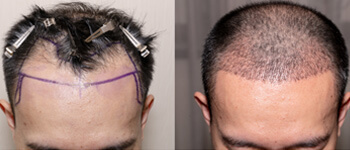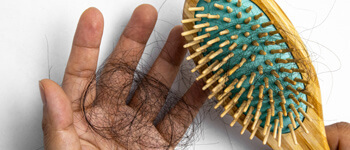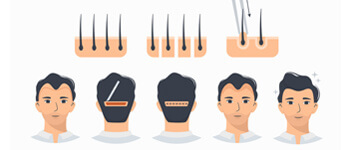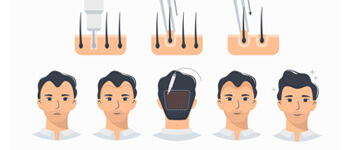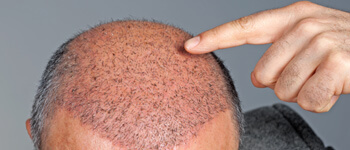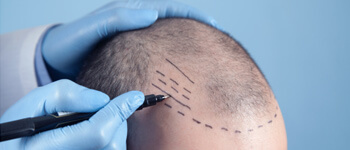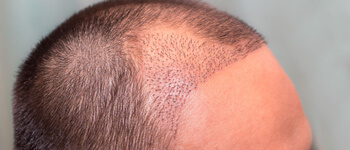Hair fall and male pattern baldness are extremely common and affect a significant percentage of the male population. Approximately 66% of men experience some degree of hair loss by the age of 35, whereas 85% notice hair thinning by the age of 50.
Male pattern baldness is acquired from parents and often runs in families. Based on their family history, some men may notice baldness in their teens. Hair may get thinner over time but also get softer and shorter.
When the cause of your hair fall is genetic, other treatment options may seldom work. For this reason, you might be tempted to try hair transplant surgery.
Hair transplants for men require minimal aftercare and are the only long-lasting solution to hair loss. But before you pick this option, it’s wise to get a clear understanding of the early signs of hair loss.
Early Signs Of Hair Fall In Men
The signs of hair loss can show up in different ways. One common warning is finding excessive hair in the comb or shower drain.
Other signs of hair loss in men include thinning hair, receding hairline, and bald patches on certain areas of the scalp. These bald patches might also appear on the beard or eyebrows. If you catch these hair fall signs early, you could stop the condition from worsening with medical treatments. But the only surefire way to treat hair loss completely is with a hair transplant. If you’re wondering how a hair transplant works, read on for a breakdown.
Hair Transplants For Men
A hair transplant is a surgery that involves taking existing hair and transferring it to an area with no hair. The hair may be taken from any part of the body, but usually, it’s taken from the back of the head.
Hair transplant surgery can be conducted by two methods: Follicular Unit Transplantation (FUT) and Follicular Unit Extraction (FUE). Before either surgery, the site of hair removal is sterilized and numbed with a local anaesthetic. The subsequent steps for the individual surgeries are listed below:
Follicular Unit Transplantation (FUT)
- The surgeon first removes a piece of the scalp, usually from the back. Subsequently, the area where the scalp was removed is stitched up.
- The scalp is then separated into smaller pieces, with each piece containing up to 2000 fragments called grafts.
- The surgeon then makes holes in the area where hair will be transplanted. Hair from the removed pieces of the scalp is then inserted into the holes in a process called grafting.
- Finally, the surgical site is covered up with bandages.
Follicular Unit Extraction (FUE)
- Hair is shaved off by the surgeon from the back of the head.
- Like with the FUT procedure, the individual follicles removed from the scalp are then grafted into the holes.
- Finally, the surgical site is covered with bandages or gauze.
The major difference is that in FUE, the follicular units are directly extracted from the scalp. However, in FUT, the hair is removed from a strip of donor skin.
Hair Transplant Benefits
A hair transplant surgery carries many obvious benefits. Since it is a minimally invasive surgery, the patient can return home the very same day. If successful, a hair transplant surgery is also a permanent solution to hair loss.
The two different methods of hair transplant carry different benefits. FUE is more common and comes with a quicker healing time than FUT, less pain, and scarring. FUT is a better option for a shorter operation time and is economically affordable.
Hair Transplant Side Effects
Scarring is the most common side effect of hair transplants and is completely unavoidable. Other potential side effects include:
- Infections
- Scalp itching
- Swelling
- Bleeding
- Hair loss
Some people may even lose sensation around the surgical site and experience inflammation. However, these side effects can be treated with medication and effective aftercare.
Other Factors To Consider For Hair Transplant Surgery
Eligibility
You may be ineligible for a hair transplant if:
- Your hair volume and quality do not match the acceptable criterion
- You have other conditions, such as trichotillomania (hair-pulling disorder) or complete alopecia.
Talk to your doctor or a transplant surgeon about your expectations before you decide to get either hair transplant procedure.
Risks
As with any other surgery, hair transplants carry some risks, such as bleeding and infection. In some cases, scarring or unnatural growth may also be one of the consequences.
With new hair growth, inflammation or infection may also occur along with sudden loss of the original hair on the transplant site. This phenomenon is termed shock loss and is likely temporary.
Ultimately, the potential risks of hair transplant surgery may be worth the reward if you have exhausted all other solutions. Still, it’s best to consult a dermatologist to understand the risks in detail.
Duration
Hair transplant surgery is a fairly long procedure and can take between 4 to 8 hours. In case of large hair transplants, the patient is required to return another day.
Recovery
Both hair transplant procedures may take several hours to several days to complete. In either case, however, you will be allowed to leave the hospital the same day.
For the first 2 to 3 weeks post-surgery, the transplanted hair will fall out. And results and new growth will be seen within a few months. Most people notice 60% of hair growth after 6-9 months.
Hair Transplant: Precautions And Aftercare
Post-surgery, you will be required to take certain precautions for optimal results. The area of surgery may be swollen for a few days, and you might even experience pain or soreness.
In order to avoid discomfort, you must take the surgeon’s prescribed medications religiously. These may include pain medications such as ibuprofen, antibiotics for possible infections, and oral steroids to reduce swelling,
Some additional aftercare tips include:
- Avoid washing the hair for a few days after the surgery.
- Use only mild shampoos for a few weeks.
- While you can return to work in three days or so, it is advisable to avoid exercise and other strenuous activities for around a week.
- Brushing or combing over the new grafts must be avoided for about 3 weeks, along with wearing hats.
Conclusion
Hair transplants are a good hair fall solution for men. However, much like any other surgery, hair transplant procedures don’t carry a hundred percent guarantee. You are likely to notice some early hair fall, and full results will be visible only after a few months.
Therefore, it is advisable to seek professional help for your hair loss before making a final decision. For more ways to prevent hair loss or to schedule a consultation with an expert, explore Skin and Hair Academy today.


